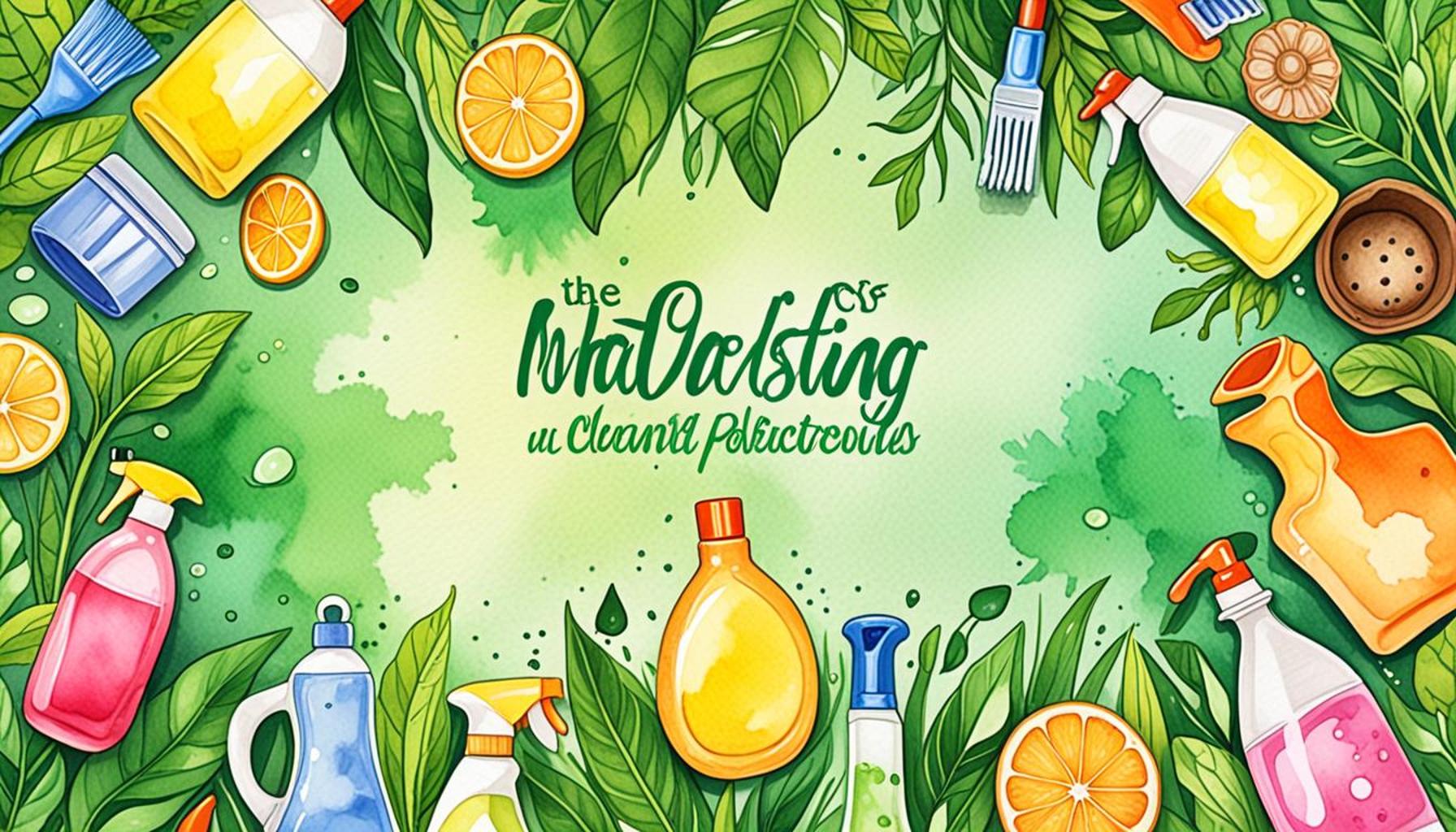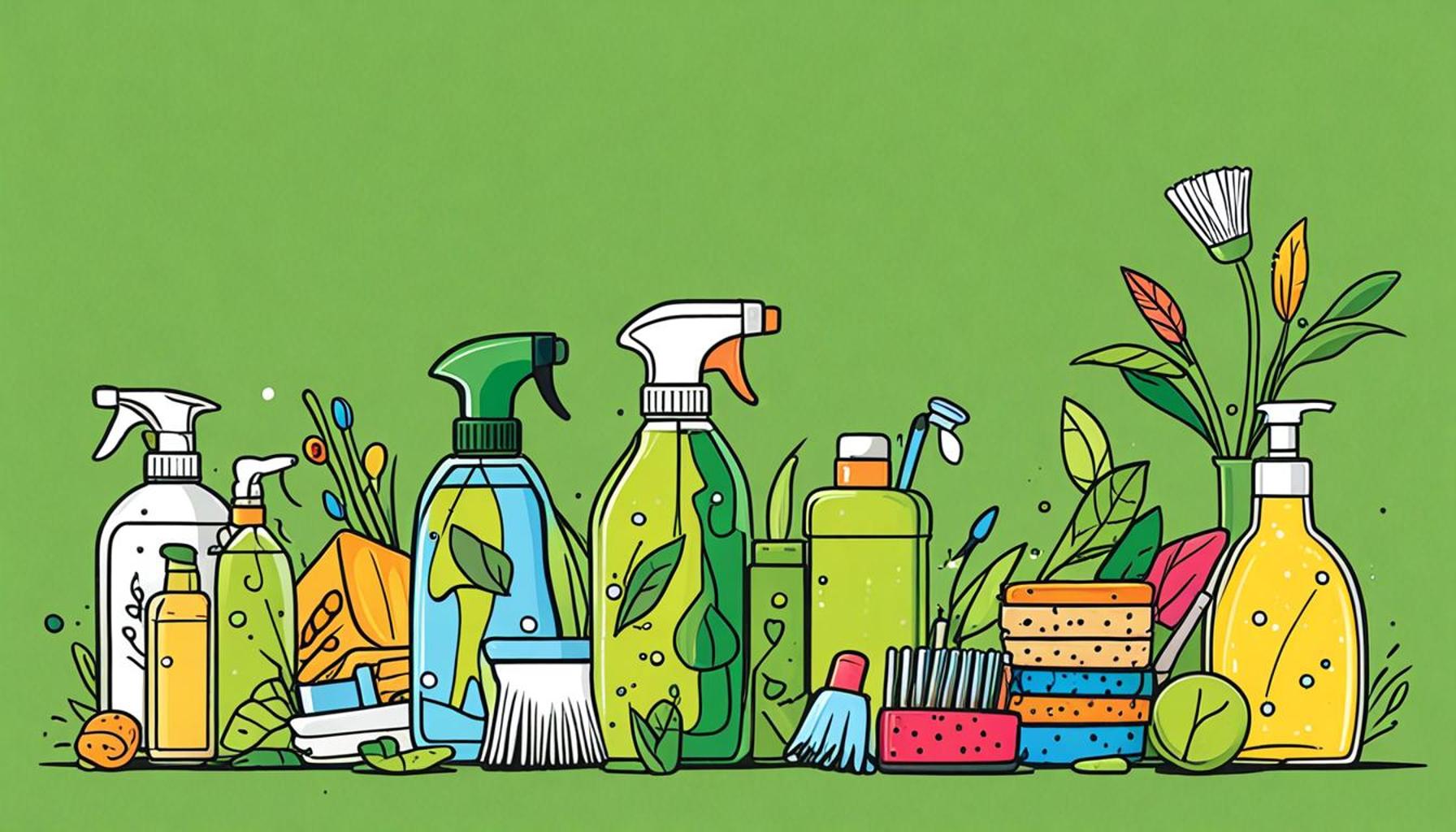The Role of Natural Ingredients in the Effectiveness of Eco-Friendly Cleaning Products: Myths and Truths

Understanding Eco-Friendly Cleaning Products
The growing interest in eco-friendly cleaning products reflects a broader trend of environmental awareness that has taken root in society. Today, consumers are more vigilant about the ingredients in their household products, pushing for those that are made with natural ingredients and are marketed as sustainable alternatives. This shift prompts pertinent questions about their actual performance and any potential downsides.
Marketing vs. Reality
One of the first issues consumers encounter is the distinction between marketing claims and the reality of eco-friendly cleaning solutions. Many brands tout terms like “natural,” “non-toxic,” or “biodegradable,” but these labels can be misleading. For instance, a product might be derived from natural sources yet still contain harmful compounds. The terms “natural” and “organic” are not strictly regulated, leading to ambiguity. Therefore, it’s important for consumers to scrutinize the ingredient list, looking for known effective agents like vinegar or baking soda that can cut through grime effectively.
Ingredient Efficacy
When it comes to cleaning effectiveness, certain natural ingredients have been scientifically supported for their cleaning powers. For example, lemon juice has antibacterial properties and can help remove stains, while baking soda functions as a mild abrasive that neutralizes odors. Conversely, ingredients like *tea tree oil* are praised for their antimicrobial properties, though their effectiveness can vary based on factors like concentration and application method.
However, some so-called “natural” ingredients may not perform as claimed. For instance, while products with essential oils may smell delightful, their actual cleaning power may not match that of traditional chemical cleaners, particularly when tackling severe stains or bacterial outbreaks in kitchens and bathrooms.
Environmental Impact
The environmental impact of using eco-friendly products extends beyond mere manufacturing. Many consumers believe that by opting for green cleaning solutions, they are contributing to the reduction of hazardous waste and pollution. However, this perspective is nuanced. While eco-friendly cleaners typically avoid harsh chemicals that harm aquatic life, some still present challenges. For instance, the production of natural ingredients often involves agricultural practices that can lead to environmental degradation if not managed sustainably.
Moreover, the packaging of these eco-friendly products often plays a role in their overall environmental footprint. Many brands now emphasize recyclable or biodegradable materials to appeal to eco-conscious buyers. However, consumers must remain aware of local recycling regulations and the actual efficacy of the claims made on the packaging.
In conclusion, as the interest in natural cleaning products grows, it’s crucial for consumers to navigate this landscape wisely. Armed with knowledge about ingredient effectiveness and a critical eye on marketing tactics, they can make informed choices that align with their values as well as their cleaning needs. By staying informed, you can truly contribute to a cleaner, greener home without compromising on effectiveness.
LEARN MORE: Click here for efficient cleaning tips
Debunking Myths Surrounding Natural Ingredients
The allure of eco-friendly cleaning products often hinges on the perception that natural ingredients are inherently safer and more effective. However, the intersection of natural ingredients and cleaning efficacy is riddled with misconceptions. Many consumers assume that just because a product contains plant-based components, it will outperform conventional cleaners. This assumption can mislead shoppers into ignoring critical aspects of cleaning performance and safety.
Common Misconceptions
Among the labyrinth of marketing jargon, several myths dominate the conversation about eco-friendly cleaners. Here are some prevalent misconceptions:
- All-natural equals effective: While some natural compounds possess cleaning properties, not all are effective against tough stains or bacteria. For example, natural surfactants may struggle with greasy residues compared to their synthetic counterparts.
- Green products are more expensive for no reason: Many believe that the markup on eco-friendly products doesn’t correlate with their cleaning power. However, the investment often lies in sustainable sourcing and manufacturing practices, which can contribute to marginally higher prices.
- Essential oils are a cleaning substitute: While essential oils add fragrance and can have some antimicrobial properties, relying solely on them for disinfecting can lead to inadequate cleaning in many scenarios, especially in high-risk areas like kitchens and bathrooms.
Consumer Education for Informed Decisions
As consumers navigate the myriad options available, it becomes evident that education plays a pivotal role in making informed decisions regarding eco-friendly cleaning products. The key lies in understanding that not all natural ingredients deliver the same level of efficacy. Research has shown that certain non-toxic substances can effectively tackle grime while being safe for the user and the environment, such as:
- Vinegar: Known for its acidity, vinegar can break down mineral deposits and cut through grease, making it a staple in many households.
- Baking soda: A versatile cleaner that can scrub surfaces without scratching, it also neutralizes odors and unearths grime thanks to its mildly abrasive nature.
- Castile soap: This plant-based soap is biodegradable and effective in cleaning various surfaces, thanks to its ability to remove dirt and oils.
To fully discern the effectiveness of eco-friendly cleaning products, consumers must delve into ingredient transparency. Familiarity with commonly used natural cleaners and their properties enhances a buyer’s ability to discern which products may best meet their cleaning needs, leading to more empowered purchasing decisions.
As the conversation regarding eco-friendly solutions evolves, the challenges of misinformation and misunderstanding surrounding natural ingredients remain significant. By empowering themselves with knowledge, consumers can bridge the gap between myths and truths, ensuring that their commitment to sustainability does not compromise the cleanliness and health of their homes.
| Advantage | Details |
|---|---|
| Safety for Health | Natural ingredients typically contain fewer harmful chemicals, reducing risks of allergies and respiratory issues. |
| Environmental Impact | Eco-friendly products generally break down more easily, contributing to less pollution and a lower carbon footprint. |
| Effectiveness | Recent studies show that natural cleaning agents can be equally as effective as their synthetic counterparts in many applications. |
| Consumer Demand | The growing market preference for sustainable products encourages innovations in natural cleaning formulations. |
The ongoing debate surrounding the role of natural ingredients in eco-friendly cleaning products often opens up new avenues for discussion. Many consumers are driven by the promise of transparency regarding ingredient sourcing and the motivation to make more sustainable choices. By prioritizing natural ingredients, manufacturers not only aim to boost their brand credibility but also respond to consumer demand for products that align with their values of health and environmental responsibility.Furthermore, the effectiveness of natural products has been widely researched, challenging the long-held myths that they are inferior in cleaning power compared to chemical-laden alternatives. Effective eco-friendly cleaning solutions often harness the power of plant-based enzymes and essential oils that not only clean surfaces but do so without compromising safety.In essence, what emerges from these discussions is a blend of myth and truth that shapes our understanding of eco-friendly cleaning products. The conversation continues, evolving based on scientific findings, consumer preferences, and environmental considerations.
DISCOVER MORE: Click here to learn about the science behind eco-friendly cleaning products
The Science Behind Natural Ingredients
To sift through the haze of myths surrounding natural ingredients in eco-friendly cleaning products, it’s essential to understand the science that underpins their effectiveness. While marketing often portrays natural components as universally effective, the reality is that their cleaning capabilities vary considerably, depending on the specific compound and its application.
Effectiveness of Specific Natural Ingredients
Research into the cleaning powers of various natural ingredients reveals both potential and limitations. For instance, citrus extracts, primarily derived from oranges and lemons, contain d-limonene, a powerful solvent that can dissolve grease and eliminate odors. This characteristic makes citrus-based cleaners particularly effective for kitchen environments. However, while d-limonene is beneficial, it does not match the potency of synthetic solvents in every scenario, especially for heavy-duty cleaning tasks.
Another popular natural cleaning agent is coconut oil, known for its antimicrobial properties, which can be a game-changer in reducing bacteria on surfaces. Yet, it’s important to use it judiciously as it may not always function as an all-encompassing cleaner due to its viscosity, which can leave residue if not properly rinsed.
The Need for Combinations
Indeed, the effectiveness of many natural ingredients can be amplified when combined with each other or with known safe synthetics. For example, vinegar and baking soda offer a powerful duo that not only neutralizes odors but also tackles stubborn grime through chemical reactions that create effervescence, making it easier to dislodge dirt. This compound approach mirrors the strategies employed in professional cleaning contexts, where multiple agents are often deployed for maximum efficacy.
Environmental Impact versus Performance
While the role of natural ingredients in cleaning is essential, evaluating their environmental impact is equally vital. It is crucial to note that natural does not automatically mean environmentally benign. For instance, certain plant-based surfactants are derived from crops that require extensive agricultural practices, which can include fertilizers and pesticides that may harm local ecosystems.
Moreover, production considerations should not be overlooked. The processing of natural ingredients, such as essential oils, can involve significant energy consumption, potentially offsetting their eco-friendly status. As consumers strive for sustainable cleaning options, they should consider the entire lifecycle of cleaning products—from ingredient sourcing to packaging and waste management—as part of their purchasing criteria.
The Bottom Line for Conscious Consumers
Ultimately, the effectiveness of eco-friendly cleaning products hinges on a nuanced understanding of what makes natural ingredients work. Consumers should remain skeptical of blanket claims regarding ‘natural’ products and dig deeper into ingredient lists. Factors such as pH balance, solvent capability, and the presence of active compounds can significantly influence a product’s overall performance.
In a market rich with choices, informed consumers who scrutinize product labels and seek out comprehensive information on ingredient efficacy can make well-rounded decisions that honor both their cleaning needs and their commitment to sustainability. The transition to natural cleaners becomes a journey of discovery, one where knowledge empowers healthier living environments for homes and the planet alike.
DISCOVER MORE: Click here to find out how decluttering can enhance your cleaning routine
Conclusion
As consumers increasingly seek sustainable solutions, the role of natural ingredients in eco-friendly cleaning products remains a focal point of discussion. The allure of these products, often promoted as effective yet gentle on the environment, demands a critical examination. While natural components like citrus extracts, coconut oil, and vinegar can indeed provide valuable cleaning properties, their actual effectiveness varies widely and often depends on the context of their use.
It is essential to debunk the myth that all natural substances are universally superior to their synthetic counterparts. This perspective overlooks the importance of synergistic combinations and the specific roles that various ingredients play in cleaning. Effective eco-friendly cleaning often relies on a blend of ingredients that play off each other’s strengths, demonstrating that natural does not always mean sufficient.
Moreover, the environmental implications of natural ingredients merit consideration. From agricultural practices to energy-intensive processing, the path of natural ingredients is not inherently devoid of environmental impact. Thus, a holistic approach—considering the entire lifecycle of a product—is essential for conscious consumers.
In conclusion, making informed choices in the realm of eco-friendly cleaning products requires a blend of curiosity and skepticism. By understanding the real attributes of natural ingredients and scrutinizing product labels, consumers can forge a path toward effective cleaning that also promotes sustainability. This journey not only emphasizes healthier living environments but also invites us to engage actively with how we clean, paving the way for a greener future.


